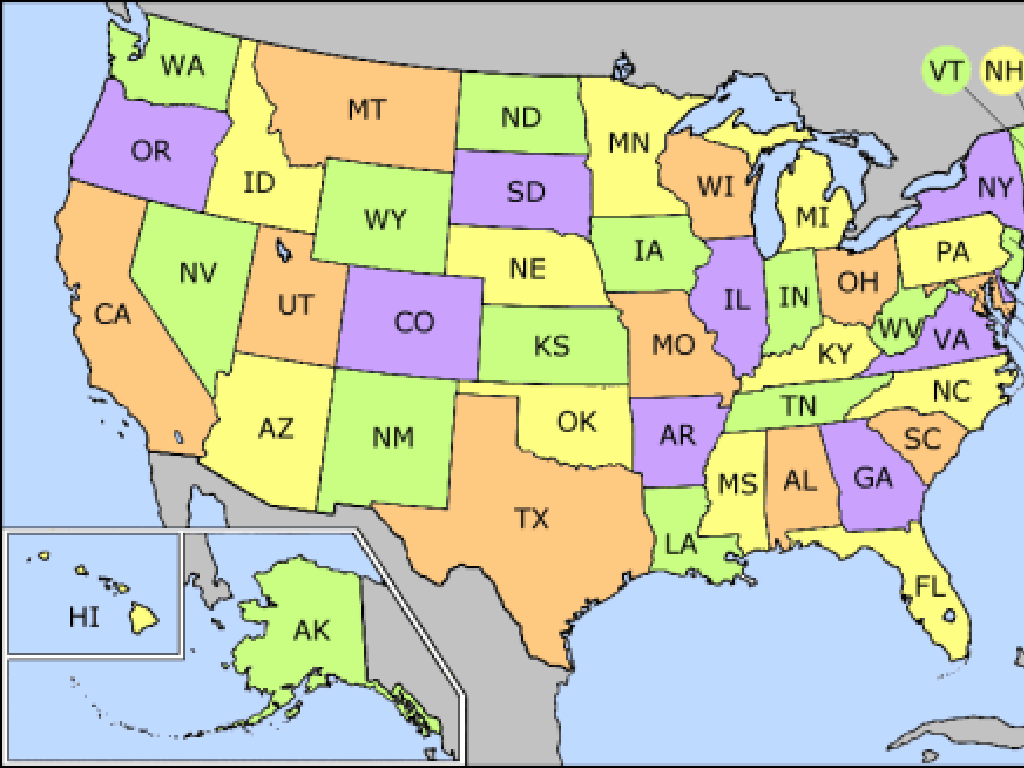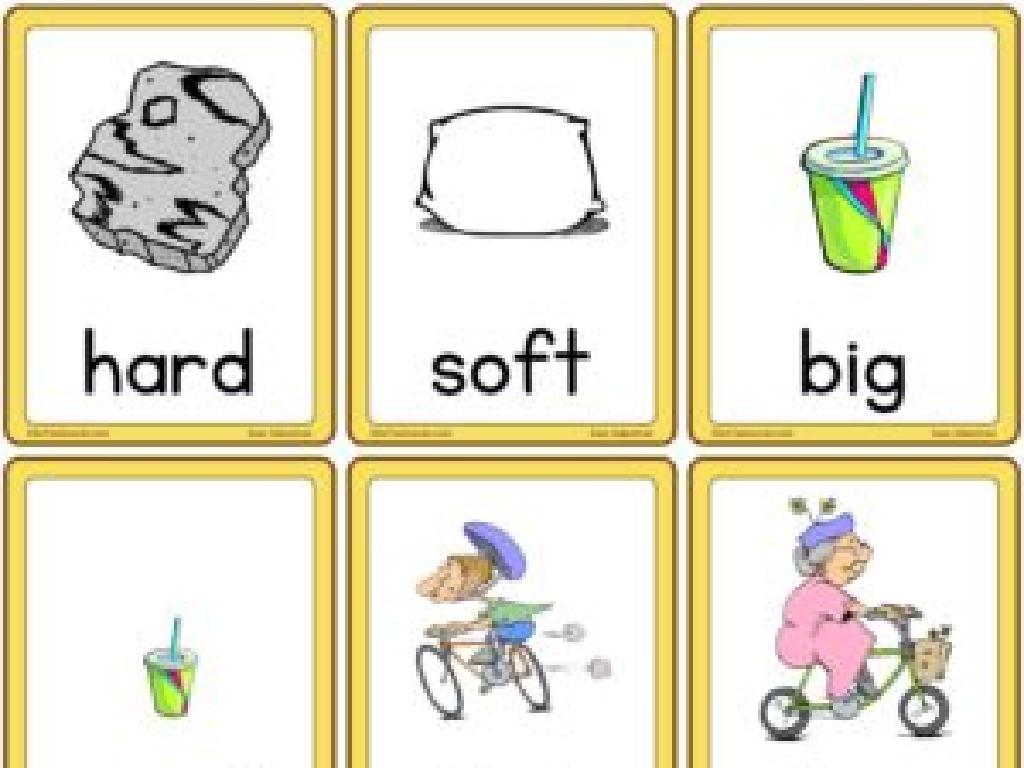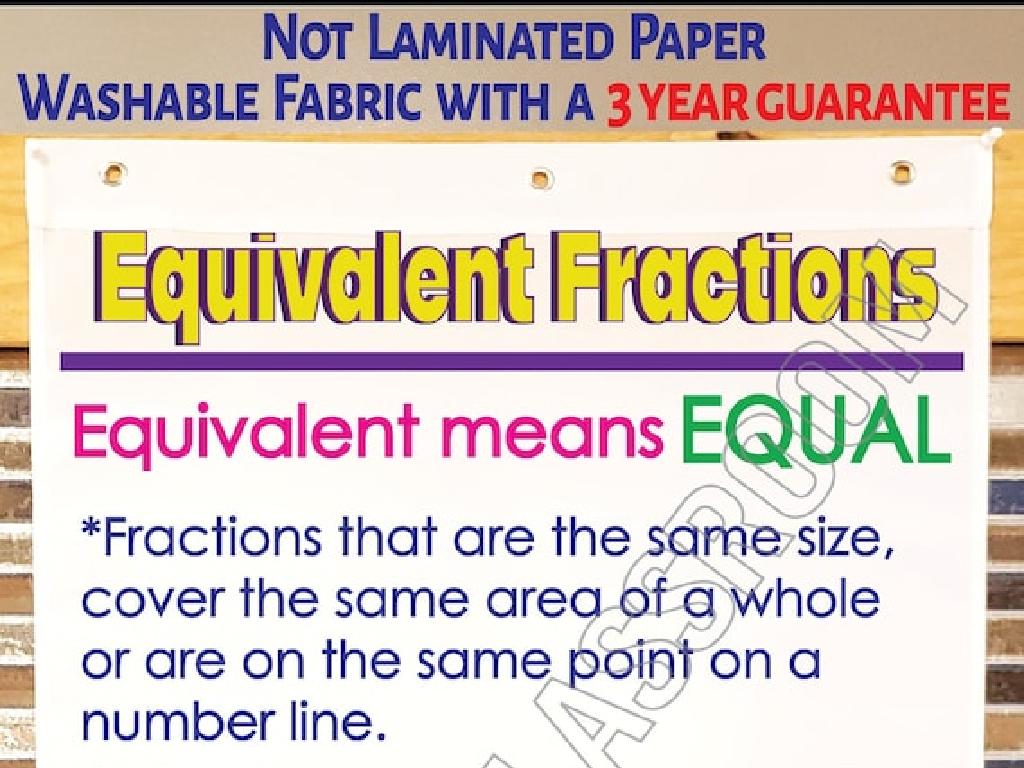Words With Sub-
Subject: Language arts
Grade: Sixth grade
Topic: Prefixes And Suffixes
Please LOG IN to download the presentation. Access is available to registered users only.
View More Content
Exploring the Prefix ‘sub-‘
– Prefixes and suffixes basics
– ‘sub-‘ means under or below
– Like ‘submarine’ a boat that travels under water
– Examples of ‘sub-‘ words
– ‘Submerge’ to put under water, ‘subtract’ to take one number under another
– Practice with ‘sub-‘
– Find words with ‘sub-‘ in your favorite book
|
This slide introduces the concept of prefixes and suffixes, focusing on the prefix ‘sub-‘. Begin by explaining that prefixes are added to the beginning of words to change their meaning, while suffixes are added to the end. Emphasize that ‘sub-‘ typically means under or below. Provide clear examples like ‘submarine’, which operates under the water, and ‘submerge’, which means to put something under water. Encourage students to think of other ‘sub-‘ words and how the prefix alters their meaning. For practice, ask students to look for words with the prefix ‘sub-‘ in books they enjoy or in their environment, fostering an interactive and engaging learning experience.
Exploring Prefixes: The Power of ‘sub-‘
– Define a prefix
– A prefix is a set of letters at the start of a word
– Prefixes alter root words
– ‘sub-‘ as an example
– ‘sub-‘ means under or below
– Examples: ‘submarine’, ‘subtract’
– ‘submarine’ (underwater vessel), ‘subtract’ (take away)
|
This slide introduces the concept of prefixes, focusing on how they modify the meanings of root words. A prefix is a letter or group of letters added to the beginning of a word to create a new word with a different meaning. ‘sub-‘ is a common prefix that students will encounter, which means ‘under’ or ‘below’. Examples like ‘submarine’, which operates under the water, and ‘subtract’, which means to take away or deduct, illustrate the use of the ‘sub-‘ prefix. Encourage students to think of other words with the ‘sub-‘ prefix and discuss how the meaning changes. This will help them understand the power of prefixes in language arts.
Exploring ‘sub-‘: Diving Below the Surface
– ‘sub-‘ means ‘under’ or ‘below’
– Examples: submarine, submerge, subzero
– ‘submarine’: a vessel that navigates underwater
– Breaking down ‘submarine’
– ‘submerge’: to go below the water’s surface
– Breaking down ‘submerge’ and ‘subzero’
– ‘subzero’: temperatures falling below 0 degrees
|
This slide introduces the prefix ‘sub-‘ and its meaning, which is a foundational concept in understanding how prefixes can alter the meaning of root words. Start by explaining the definition of ‘sub-‘ and then present real-world examples that the students can relate to. For instance, a submarine is a type of ship that travels under the water, which directly relates to the meaning of ‘sub-‘. Similarly, to submerge something means to put it under water, and subzero temperatures are those below zero degrees. Encourage students to think of other words with the prefix ‘sub-‘ and discuss what those words might mean. This will help them deduce meanings of unfamiliar words in the future.
Exploring ‘Sub-‘ Prefixes
– ‘Submarine’: operates underwater
– ‘Submarine’ combines ‘sub-‘ (under) with ‘marine’ (sea-related)
– ‘Submerge’: go below water surface
– ‘Submerge’ has ‘sub-‘ (under) and ‘merge’ (to dip or sink into)
– ‘Subzero’: below zero degrees
– ‘Subzero’ uses ‘sub-‘ (below) to describe temperatures under 0°C or 32°F
– Understanding ‘sub-‘ in words
|
This slide introduces the prefix ‘sub-‘ and its meaning of ‘under’ or ‘below.’ Students will see how ‘sub-‘ is used in different words to change their meaning. ‘Submarine’ refers to something operating under the sea, ‘submerge’ means to go below the surface of the water, and ‘subzero’ describes temperatures below zero degrees. Encourage students to think of other words with the prefix ‘sub-‘ and discuss how the meaning changes. This will help them understand how prefixes can alter the meaning of root words and enhance their vocabulary.
Exploring ‘sub-‘ in Sentences
– Craft sentences with ‘sub-‘ words
– Create original sentences using words like ‘submarine’ or ‘subtract’.
– Share and explain meanings in class
– Explain how ‘sub-‘ affects the word’s meaning, like ‘subzero’ means below zero.
– Discuss ‘sub-‘ impact on context
– How does ‘sub-‘ modify the meaning in your sentences? Does it imply ‘under’ or ‘below’?
– Reflect on the usage of ‘sub-‘
– Think about when and why we use ‘sub-‘ in our daily language.
|
This slide encourages students to actively engage with the prefix ‘sub-‘ by creating their own sentences and sharing them with the class. The activity aims to deepen their understanding of how ‘sub-‘ can alter the meaning of a word and the overall context of a sentence. For example, ‘submarine’ a vessel that goes under water, ‘subtract’ to take away from a total, or ‘suburban’ an area below or outside of an urban area. By discussing and reflecting on these examples, students will learn to recognize and use ‘sub-‘ words effectively in their writing and speech. The teacher should facilitate discussion, ensuring each student has a chance to participate and provide feedback on others’ sentences.
Activity Time: ‘Sub-‘ Word Hunt
– Hunt for ‘sub-‘ words around you
– Write down each word and its meaning
– For example, ‘submarine’ means under the sea
– Share your findings with the class
– Discuss the ‘sub-‘ prefix significance
– Understand how ‘sub-‘ changes word meanings
|
This activity is designed to engage students in exploring their environment to find words that begin with the prefix ‘sub-‘. It encourages them to be observant and think about the words they encounter in their daily lives. The activity also aims to enhance their understanding of how prefixes can alter the meaning of a word and how common the ‘sub-‘ prefix is in English. After the hunt, facilitate a discussion where students share the words they found and explain their meanings. This will help reinforce their understanding of the ‘sub-‘ prefix and its role in word formation. Possible words they might find include ‘subtitle’, ‘submerge’, ‘subway’, or ‘subheading’. Encourage creativity and ensure that every student participates in the sharing session.
Class Activity: Create a ‘Sub-‘ Poster
– Form small groups for poster making
– Include at least five ‘sub-‘ words
– Examples: submarine, substitute, subtract
– Add pictures representing each word
– Draw or find images that illustrate the words
– Present your poster to the class
|
This activity is designed to help students understand and apply their knowledge of the prefix ‘sub-‘. By working in groups, they will collaborate to create a visual representation of words that begin with ‘sub-‘. Encourage creativity in both the selection of words and the corresponding images. Possible ‘sub-‘ words include ‘submarine’, ‘submerge’, ‘substandard’, ‘substitute’, and ‘subtract’. Each group will present their poster, explaining their word choices and how the images represent the meaning of each word. This will reinforce their understanding of the ‘sub-‘ prefix and how it alters the meaning of root words.
Conclusion & Homework: The Power of ‘sub-‘
– Recap: Understanding ‘sub-‘
– ‘sub-‘ means under or below, like submarine or submerge.
– Prefixes unlock word meanings
– Knowing ‘sub-‘ can help guess the meaning of new words.
– Homework: Craft a ‘sub-‘ story
– Write a creative story using 10 words that start with ‘sub-‘.
– Share stories in the next class
|
As we wrap up today’s lesson, remind students of the importance of the prefix ‘sub-‘ and how it changes the meaning of words. Emphasize that recognizing prefixes like ‘sub-‘ can be a powerful tool in expanding vocabulary and understanding unfamiliar words. For homework, students are tasked with writing a short story that includes at least 10 words beginning with ‘sub-‘. This will help reinforce their understanding of the prefix and encourage them to apply their knowledge creatively. In the next class, students will have the opportunity to share their stories, which will not only enhance their learning but also allow them to practice their storytelling skills.






